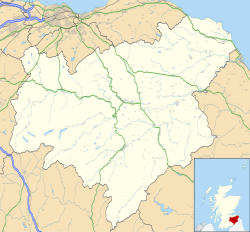Edin's Hall Broch
 Edin's Hall Broch, aerial photograph | |
| Alternative name | Edinshall Broch |
|---|---|
| Location | Duns |
| Coordinates | 55°50′08″N 2°21′53″W / 55.835506°N 2.364856°W |
| Type | Broch |
| History | |
| Periods | Iron Age |
| Site notes | |
| Ownership | Historic Scotland |
| Public access | Yes |
Edin's Hall Broch (also Edinshall Broch; Woden's Hall Broch) is a 2nd-century broch near Duns in the Borders of Scotland. It is one of very few brochs found in southern Scotland.[1] It is roughly 28 metres in diameter.
Name
[edit]In the late 18th century this site was called "Woden's Hall or Castle" (Woden being the chief god from Anglo-Saxon mythology).[2] Its later name change apparently recalls the legend of the three-headed giant The Red Ettin known in tales and ballads.[2]
Location
[edit]Edin's Hall Broch is one of the most southerly broch survivals, which are more typically associated with Northern Scotland.[3] It is 4 miles north of the town of Duns.[3] It stands on the northeast slope of Cockburn Law just above a fairly steep slope down to the Whiteadder Water.[4]
The broch stands in the northwest corner an Iron Age hillfort which presumably pre-dates the broch.[4] The hillfort consists of a double rampart and ditches, enclosing an oval area some 135 metres by 75 metres.[4] The entrance was on the west side.[4] A large circular structure (roundhouse) in the centre of the fort, close to the broch, may have been the most important building before the broch's construction.[5]
Dating
[edit]It is assumed that the hillfort dates to the pre-Roman Iron Age. The date of the broch is uncertain but it has been speculated that it was built between the two main periods of Roman occupation in Scotland: some time in the 2nd century AD. Excavations at Torwoodlee Broch, also in the Scottish Borders, has shown that it was built and demolished during this period.[6]
Within the hillfort is an array of stone footings marking the positions of houses and other structures.[5] Some of the houses overlie the defences – indicating that they are later than hillfort and may be later than the broch as well.[4]
Description
[edit]


The broch has an external diameter of 28 metres,[4] and an internal diameter of 17 metres.[3] This is unusually large compared with a typical Highland broch and suggests that it may not have been as tall as the northern brochs.[5] The walls of the broch survive to a height of between 1.0 and 1.8 metres.[4] The entrance passage is on the east side and has two guard chambers flanking the doorway.[4] The interior of the broch has three intramural cells which are all approximately dumb-bell shaped.[4] The cell on the south side has the remains of a stone stairway at its north end which presumably rose to the wallhead.[4]
The broch lies within a rectangular enclosure measuring about 58 by 54 metres.[4]
Excavations
[edit]Edin's Hall was "cleared" by antiquarians in the 19th century.[4] The relics recovered were donated to the National Museum of Scotland. These included a stone spindle whorl, a piece of a jet ring, an amber bead, bones, an oyster shell, and a fragment of a glass bracelet.[4]
Two copper ingots, one of which is now in the National Museum, were apparently found with a metal detector inside the broch in 1976.[4] The ingots were derived from local copper mines and may have been an important source of wealth for the inhabitants.[4]
An archaeological survey and sample excavation was conducted in 1996.[4] A few artefacts including coarse pottery and a stone spindle whorl were recovered.[4]
References
[edit]- ^ Armit, I. (2003) Towers in the North: The Brochs of Scotland. Stroud. Tempus. ISBN 0-7524-1932-3 pp119-132.
- ^ a b John R. Baldwin (1985) Lothian and the Borders, page 132. RCAHMS.
- ^ a b c Ritchie, J N G (1998). Brochs of Scotland. Shire Publications. p. 52. ISBN 0747803897.
- ^ a b c d e f g h i j k l m n o p q Historic Environment Scotland. "Edin's Hall (58777)". Canmore. Retrieved 17 September 2014.
- ^ a b c "Edin's Hall Broch". Historic Scotland. Retrieved 17 September 2014.
- ^ Historic Environment Scotland. "Torwoodlee (54353)". Canmore. Retrieved 17 September 2014.

